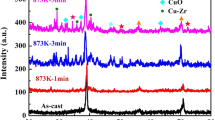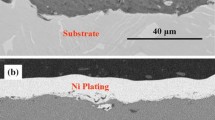Abstract
In this work, a metal–glass joint between Ti and K9 glass was obtained by vacuum diffusion bonding after Ti was pre-oxidized at different temperatures to explore the effect of the pre-oxidation procedure on the properties of diffusion bonding joints. For the oxide layer, X-ray diffraction revealed that the oxide film consisted of TiO2 and some low-valence Ti–O compounds such as Ti6O, Ti3O, TiO, etc. The x/y ratio of TixOy decreased as oxidation temperature increased. Scanning and transmission electron microscopy showed that the morphology of the oxide layer gradually changed from dense to loose and porous, and the oxidized particle size gradually increased and distributed in layers from inside to outside, with the increase in temperature. From the results of diffusion bonding at 700 °C for 2 h, good Ti-K9 joints without cracks and pores can be obtained when the pre-oxidation temperature attained 900 °C. A transition layer appeared at the Ti-K9 interface with the diffusion of elements Ti, Si, and O, etc. Shear strength tests showed that the structure of the oxide layer at different conditions can directly affect the strength of the joint between Ti and glass. The joint to Ti pre-oxidized at 900 °C exhibited the highest shear strength, producing an average failure strength of 20.6 ± 1.2 MPa. An appropriate amount of oxide layer can improve the quality of the Ti-K9 joint. The feasibility of diffusion bonding added to process versatility for the use of Ti-K9 joint on practical application.














Similar content being viewed by others
References
Axinte E (2011) Glasses as engineering materials: a review. Mater Des 32(4):1717–1732
Wang Z, Gao Z, Chu J, Qiu D, Niu J (2020) Low temperature sealing process and properties of kovar alloy to DM305 electronic glass. Metals Open Access Metall J 10(7):941
Yi R, Chen C, Li Y, Peng H, Zhang H, Ren X (2020) The bonding between glass and metal. Int J Adv Manuf Technol 111:963–983
Boccaccini AR (2005) Continuous fibre reinforced glass and glass-ceramic matrix composites. In: Bansal NP (eds) Handbook of ceramic composites. Springer, Boston, pp 461–484
Liu CR, Zhao JF, Lu XY, Meng QS, Zhao YP, Munir ZA (2008) Field-assisted diffusion bonding and bond characterization of glass to aluminum. J Mater Sci 43(15):5076–5082. https://doi.org/10.1007/s10853-008-2583-4
Pethrick RA (2012) Composite to metal bonding in aerospace and other applications. In: Chaturvedi MC (eds) Welding and joining of aerospace materials. Elsevier, Glasgow, pp 288–319
Briand D, Weber P, Rooij N (2013) Metal to glass anodic bonding for microsystems packaging. In: International Conference on Transducers, Solid-state Sensors, Actuators & Microsystems
Donald IW, Mallinson PM, Metcalfe BL, Gerrard LA, Fernie JA (2011) Recent developments in the preparation, characterization and applications of glass- and glass–ceramic-to-metal seals and coatings. J Mater Sci 46(7):1975–2000. https://doi.org/10.1007/s10853-010-5095-y
Bhutani A, Bekker E, De Oliveira LG, Pauli M, Zwick T (2021) 140 GHz broadband antenna in embedded wafer-level ball grid array technology. Paper presented at the 2021 15th European Conference on Antennas and Propagation (EuCAP): 22–26 March 2021, Düsseldorf, Germany, Online
Peters M, Kumpfert J, Ward CH, Leyens C (2003) Titanium alloys for aerospace applications. Adv Eng Mater 5(6):419–427
Alloys P (1995) Light alloys—metallurgy of the light metals. Wiley, New Jersey
Cui C, Hu BM, Zhao L, Liu S (2011) Titanium alloy production technology, market prospects and industry development. Mater Des 32(3):1684–1691
Elrefaey A, Janczak-Rusch J, Koebel MM (2014) Direct glass-to-metal joining by simultaneous anodic bonding and soldering with activated liquid tin solder. J Mater Process Technol 214(11):2716–2722
Szesz EM, Lepienski CM (2017) Anodic bonding of titanium alloy with bioactive glass. J Non-Cryst Solids 471:19–27. https://doi.org/10.1016/j.jnoncrysol.2017.04.038
Rone AP, Valbusa G, Biagini E (1977) The titaniummolten glass system: interactions and wetting. J Mater Sci 12(12):2465–2474
Li P, Xu X, Tan W, Liu H, Wang X (2018) Improvement of laser transmission welding of glass with titanium alloy by laser surface treatment. Materials 11(10):2060
Hongchao K, Heng G, Jun W, Bin T, Jinshan L (2016) Diffusion bonding between Zr-based metallic glass and copper. Rare Metal Mater Eng 45(1):42–45
Akca E, Gursel A (2015) The importance of interlayers in diffusion welding - A review. Period Eng Nat Sci (PEN) 3(2):12–16
Chanmuang C, Naksata M, Chairuangsri T, Jain H, Lyman CE (2008) Microscopy and strength of borosilicate glass-to-Kovar alloy joints. Mater Sci Eng, A 474(1–2):218–224
Luo D, Shen Z (2009) Wetting and spreading behavior of borosilicate glass on Kovar. J Alloy Compd 477(1–2):407–413
Kuo CH, Cheng PY, Chou CP (2013) Matched glass-to-Kovar seals in N2 and Ar atmospheres. Int J Miner Metall Mater 20(9):874–882
Joshi R, Chhibber R (2018) Development and interface characterization of unmatched glass-metal joint. J Manuf Proce 31:787–800
Shen Z, Zhang Y, Chen Y, Song X, Zhang T (2019) Effect of pre-oxidization condition on glass-to-metal sealing. J Non-Cryst Solids 521:119488
Dong E, Yu W, Cai Q, Cheng L, Shi J (2017) High-temperature oxidation kinetics and behavior of Ti-6Al-4V alloy. Oxid Met 88:719–732. https://doi.org/10.1007/s11085-017-9770-0
Mott NF (1995). A theory of the formation of protective oxide films on metals. In: Mott NF, Alexandrov AS (eds) Sir Nevill Mott – 65 Years in physics. World Scientific, Cambridge, pp 167–169
Li W, Zhu S, Cheng W, Chen M, Shen M, Wang F (2013) SiO2-Al2O3-glass composite coating on Ti-6Al-4V alloy: Oxidation and interfacial reaction behavior. Corros Sci 74:367–378
Jiang ZH, Zhang QY (2014) The structure of glass: a phase equilibrium diagram approach. Prog Mater Sci 61:144–215
Yext WF, Shook BJ, Katzenberger WS, Michalek RC (1983) Improved glass-to-metal sealing through furnace atmosphere composition control. IEEE Trans Compon Hybrids Manuf Technol 6(4):455–459
Li S, Hu K, Hui W, Cai Y, Zhang Y (2020) Shear strength and interfacial characterization of borosilicate glass-to-metal seals. J Alloys Compd 827:154275
Donald IW (1993) Preparation, properties and chemistry of glass- and glass-ceramic-to-metal seals and coatings. J Mater Sci 28(11):2841–2886. https://doi.org/10.1007/BF00354689
Donald IW (2001) Interfacial reactions and their influence on the lifetime behaviour of glass-ceramic-to-metal seals and coatings. Ageing studies and lifetime extension of materials. Springer, Boston
Acknowledgements
This work was financially supported by the Key Technology Research and Development Program of Shandong (2019JZZY010330).
Author information
Authors and Affiliations
Corresponding author
Ethics declarations
Conflict of interest
There is no conflict of interest to declare.
Additional information
Handling Editor: Till Froemling.
Publisher's Note
Springer Nature remains neutral with regard to jurisdictional claims in published maps and institutional affiliations.
Rights and permissions
About this article
Cite this article
Chen, M., Wang, M., Yang, H. et al. Pre-oxidation of Ti and its diffusion bonding to K9 glass: microstructure and mechanism properties. J Mater Sci 57, 6790–6802 (2022). https://doi.org/10.1007/s10853-022-06947-w
Received:
Accepted:
Published:
Issue Date:
DOI: https://doi.org/10.1007/s10853-022-06947-w




